The Housing Market in 2023
Housing Market Obliterated: Pending Home Sales Post Record Drop As Deal Cancellations, Price Cuts Hit Record High. (Comment: Bidenomics, the Federal Reserve and the housing market in 2023). Be prepared to get safe or profit with a copy of Winning Mortgage, Winning Home from Amazon. (Updated from November 11, 2022).
Home prices cooled again in January, 2023. According to the S&P CoreLogic Case-Shiller prices have been falling for seven straight months. Bank failures, high interest rates, possible economic weakness/recession are likely to provide a headwind for housing prices and lead to more declines for at least a few months and possibly into 2024.
Prices fell year over year in San Francisco (-7.6%), Seattle (-5.1%), Portland, Oregon (-0.5%) and San Diego (-1.4%). They were flat in Phoenix. This has resulted in more flexible sellers. Ut the number of homes for sale remains low, limiting price declines. The limited number of homes has also provided support for home prices of new home builders as materials, labor and building costs remain more escalated than should be the case.
“More expensive, less available borrowing, especially with an unclear economic outlook, is likely to continue to limit buyer demand. Though home sales are expected to rebound in line with seasonal trends, this spring’s sales pace is expected to remain lower than last year.
2022 Wrap Up
As interest rates rose, home prices fell across the country in late 2022. Goldman Sachs says the declines will only worsen and extend through 2023. Particularly hard hit will be four cities which saw rapid run-ups in prices: San Jose, Austin, Phoenix, and San Diego. Goldman forecasts massive declines in prices of more than 25% and comparable to that of the 2008 housing crash. Overall in the 2008 crash home prices fell around 27%, according S&P CoreLogic Case-Shiller. Coupled with the price declines are expected jumps in mortgage delinquencies, especially from loans originated in 2021 and 2022. In line with our forecasts, those markets showed the greatest FOMO price increases and will see the greatest price drops. Price changes in markets like California may see exacerbated price drops due to population out-migration whereas cities like Dallas with large in-migration may see price drops mitigated.
Goldman also forecasts that interest rates will remain high for a period longer than the market currently expects. As a result, 10-year Treasury yields would peak in 2023 Q3. We aren’t so sure that will be a peak. Goldman’s prediction counts on a soft recession. If expectations change or reality doesn’t cooperate, rates will move still higher. However, a rash of bank failures could upend everything. EXERCISE CAUTION about buying a house today. Finance only what you can afford. If recession roars in, the Federal Reserve will have limited options, but you may see some lower rates for refinancing, BUT DO NOT BET ON THAT!
The Housing Market Index continues to be decimated.
We discuss this in more detail here. This chart shows it is tracking to rival the prior two major recessions for housing. The artificial propping up by the Federal Reserve (rock bottom interest rates and excessive buying of mortgage bonds) coupled with the federal government printing money in excess of anything seen in history created the 2020-2021 bubble. Everyone will now pay for that bubble.

An analysis by Tyler Durden (nom de plume) of Zero Hedge
Last week, we observed that delusion and hope can only last so long (even when one’s salary depends on it) as US homebuilder confidence crashed to COVID lockdown lows in November after failing (or refusing) to see what was obvious to everyone for months, and what homebuyers were clearly feeling as prices soared along with mortgage rates and record low affordability for most Americans. [side note: builders just began shopping more than 5000 new houses in a bulk, discounted sale to large, institutional buy to rent funds.]
Homebuyer Confidence
And don’t get us started on homebuyer confidence: just look at the red line below which has taken out all previous record lows (including the post-2006 housing bubble) and is hitting new record lows every single month…
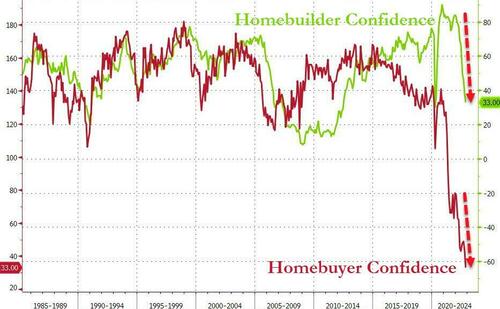
Well, slowly but surely this epic collapse in sentiment is spreading to market metrics, and while it will take between 6 and 9 months for real-time data to reach the badly lagging government-level CPI and PCE data, what’s taking place in the US housing market right now is nothing short of a meteor strike, with RedFin reporting in its latest market forecast that pending home sales fell the most on record in October and deal cancellations and price cuts hit record highs as buyers were spooked by the biggest mortgage-rate jump in over four decades.
Pending sales dropped 32.1% year over year last month, the largest decline since at least 2013, when Redfin’s records begin.
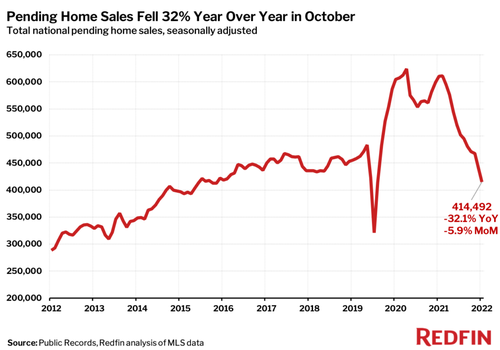
Nearly 60,000 home-purchase agreements fell through, equal to a record 17.9% of homes that went under contract.
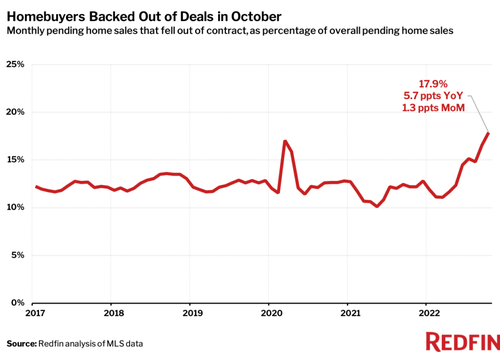
Meanwhile, almost one-quarter (23.9%) of homes for sale experienced a price drop, double the rate of a year earlier.
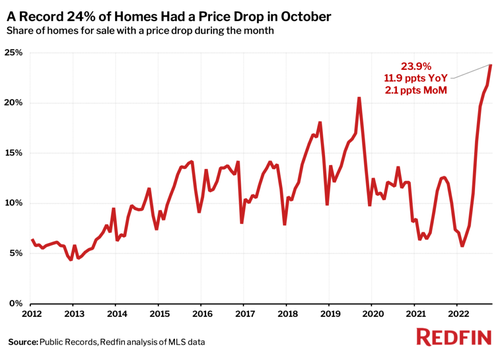
Surging mortgage rates also caused would-be sellers to stay put due to the lock-in effect. The average 30-year-fixed mortgage was 6.9% in October, up 3.83 percentage points from 3.07% one year earlier—the largest year-over-year increase during any month since 1981. That contributed to a 24% year-over-year drop in new listings, the steepest decrease on record aside from April 2020, when the onset of the pandemic brought the housing market to a near halt.

The Fallout
“The Fed’s actions to curb inflation are causing the housing market to slow at a pace not seen since the financial crisis,” said Redfin Economics Research Lead Chen Zhao. “There are already early but promising signs that inflation is cooling, which caused mortgage rates to drop last week. If that progress continues, buyers who recently backed out of deals may return to the market and sellers may be less inclined to slash their prices.”
Still, sale prices are only now just starting to fall as sellers, having held out until now, are starting to feel the need for liquidity and are increasingly hitting whatever bid they can see. And while the median U.S. home sale price declined 1.4% month over month—the largest slowdown during any October since 2012—it was still was up 4.9% from a year earlier. That will change very soon.
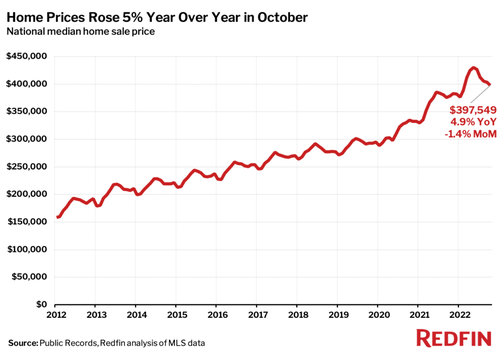
Prices may ease as listings linger on the market and competition slows. Homes that sold in October were on the market for a median of 35 days, up from 21 days a year earlier, and less than half (44.6%) of home offers written by Redfin agents faced competition. That compares with more than two-thirds (67.3%) in October 2021.
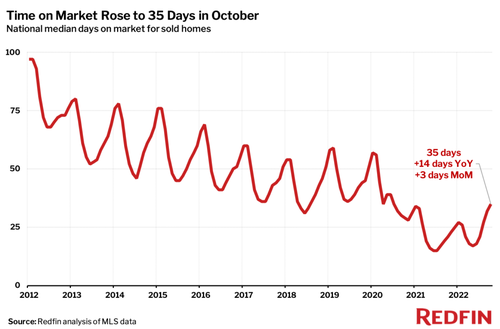
Here are the October highlights tabulated:
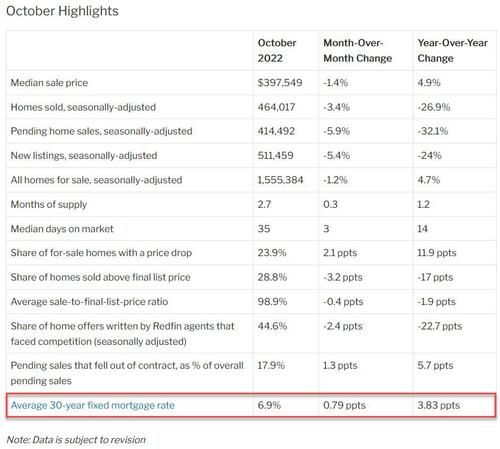
Again, none of this will show up in official US Dept of Commerce/BLS data until some time in the summer by which point the Fed may have hiked to 6% pushing the US into an all out depression.
By that time, we’ll know more about how bad Biden and the Federal Reserve made the housing market in 2023 and 2024. Because the drops won’t end in 2023!